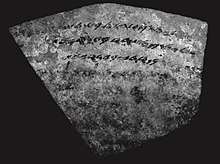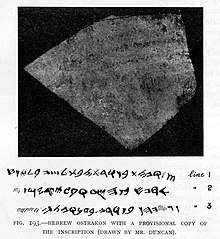Ophel ostracon
The Ophel ostracon or KAI 190, is an ostracon discovered in Jerusalem in 1924 by R. A. Stewart Macalister and John Garrow Duncan, in the area of Wadi Hilweh (known as the City of David).


The ostracon measures 4 inches by 3 inches. The inscription is thought to have originally been eight lines, of which five are decipherable (the first four and the last). According to a 2015 study, "virtually all scholars agree that it contains a list of personal names with theophoric elements."[1]
Discovery
Macalister and Duncan described the discovery as follows, referring to the 1909 expedition of Montagu Brownlow Parker:[2]
This sherd was discovered in the large cave under Field No. 9, and seems to have formed part of the dump which the Parker party deposited in that cave; its exact original provenance is therefore uncertain, though it must have come from somewhere in the neighboring tunnel, and probably not far off.
See also
References
- Faigenbaum-Golovin et al, 2015
- Macalister and Duncan p.182
Bibliography
- R.A.S. Macalister and J.G. Duncan, “Excavations on the Hill of Ophel, Jerusalem 1923-1925”, Palestine Exploration Fund Annual 4, 1926, p. 182-185
- Shira Faigenbaum-Golovin, Christopher A. Rollston, Eli Piasetzky, Barak Sober, Israel Finkelstein, The Ophel (Jerusalem) Ostracon in Light of New Multispectral Images, Tel Aviv University / George Washington University, Semitica 57 (2015): 113-137, 2015